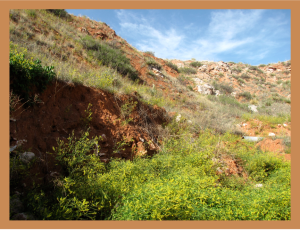We took the scenic route from Spearfish, South Dakota to Beulah, Wyoming (just across the border), and continued along the deserted blacktop. The weather that summer evening was very unusual for the high plains. Rather than hot, sunny, and nary a cloud in the sky (think “Home on the Range”), it was cool, misty and laden with atmosphere. It had a wonderful ambience, a sort of mist-hung backdrop for our moment of solitude.
Bill was looking for a certain site he had noticed from previous journeys down the freeway. A sign had indicated there was a “buffalo jump”—something used for several centuries by Native American tribes—which seemed like a good place to visit. We found a small marker on the side of the road which indicated we had arrived, though there was certainly nothing yet to see.
I guess that’s the deal with buffalo jumps. One minute you’re running along over the plains, and the next, you fall—plop—into the hole. If it were obvious, the buffalo would have noticed.
Vore Buffalo Jump
Signs warned that we were to approach at our own risk, that rattlesnakes were a hazard, and to stay on the dirt path. We saw pictures of archaeological digs previously completed at the site where twenty feet of buffalo bones had accumulated over the six hundred years of use. Though we could still see nothing unusual, the signs were promising bigger and better things to come.
We walked a dozen yards up the path (with my rattlesnake antennae well extended), and then, suddenly, the ground stopped. There was a HUGE hole in the ground, about one hundred feet deep and two hundred feet in diameter. This was a serious buffalo jump!
The utter immensity of this hole in the ground, and the unexpectedness of it on the continuous plains, provided an amazing opportunity for the Plains tribes. In preparation for their winter food supply, they would position men at the edges of the jump and bowmen around the inside of the hole. Then a group would turn a herd of buffalo toward the jump and, at the last minute, frighten them into stampeding. Once a buffalo was moving fast and in the right direction, gravity took over. Many of the buffalo died as a result of the fall. Others died from falling neighbors. And the few who didn’t die naturally were helped along by arrows from the men on the sides of the hole.
The archaeological digs have shown that the people who used this jump were able to process a lot of meat in a very short time. It was both a successful and relatively easy procedure, since they used the immense hole in the ground—along with gravity—to help them.
Now, you may be asking, “Just what do a buffalo jump and homeschooling have in common?”
There’s a GREAT answer to that question. And I’ll share it with you next time.
To be continued . . .


